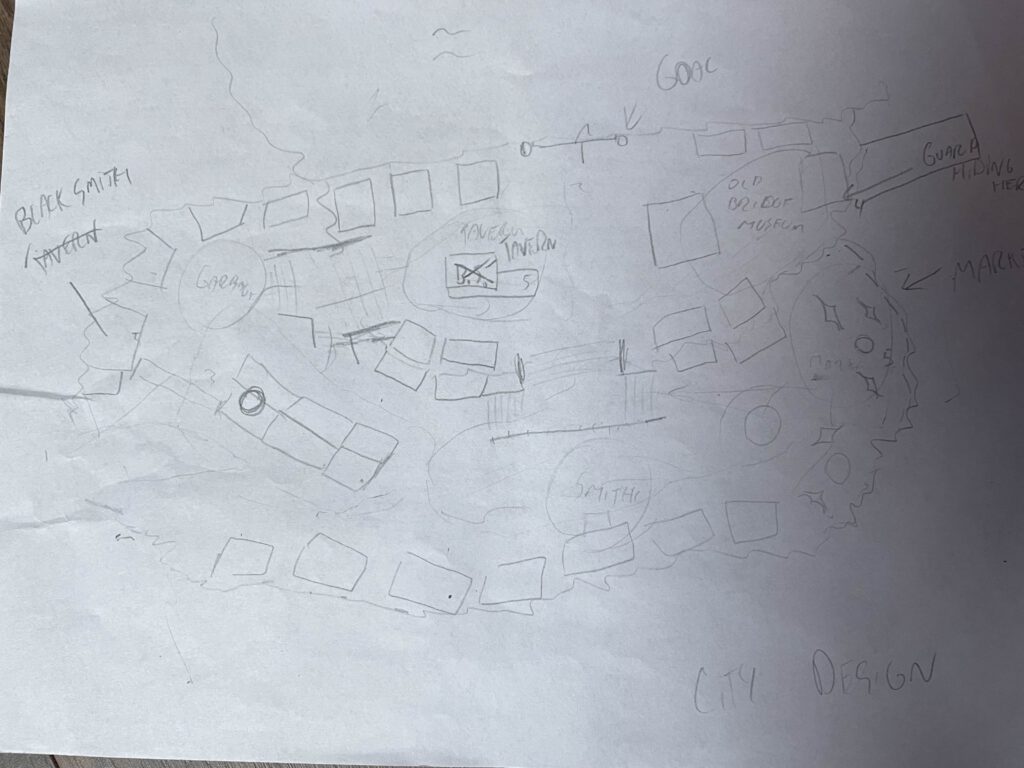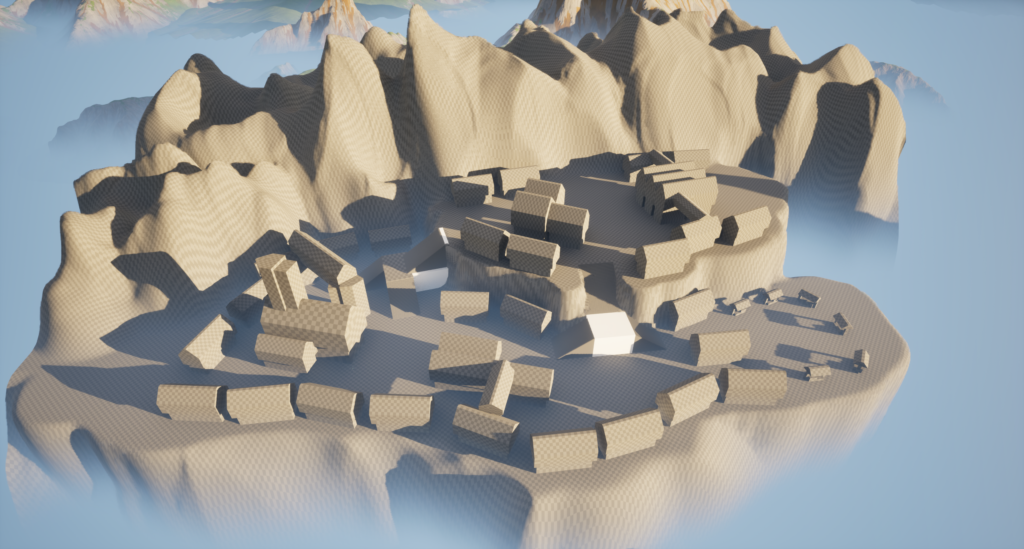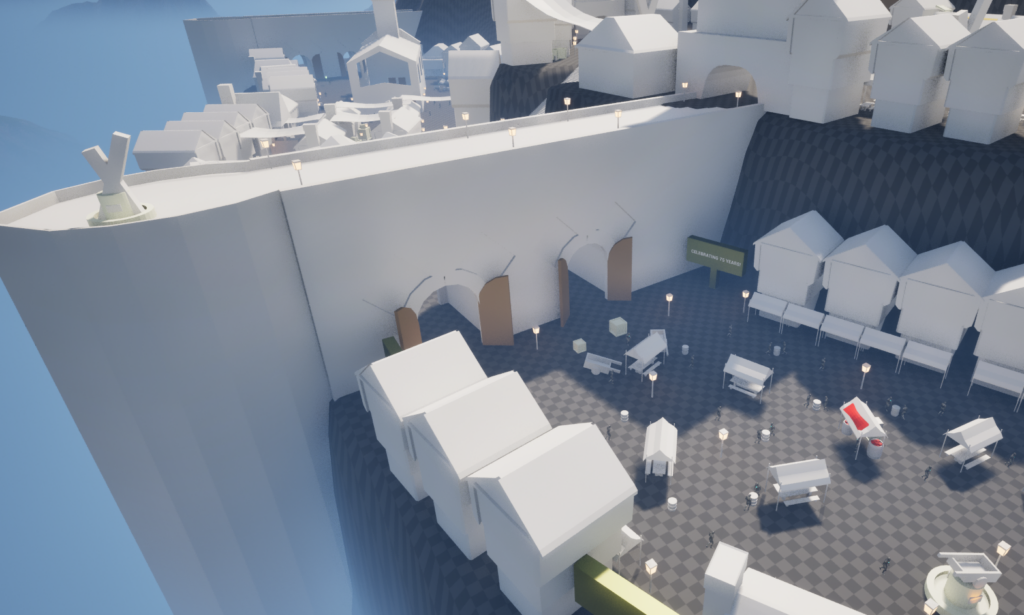
Portville
Things I've learned and improved upon:
- Open World Design
- AAA workflows
- Quest Design
- System Design
- Narrative Design
This project, I wanted to dare myself with a AAA workflow and a tight schedule (1 month).
Portville is my first dive into Open World Game design. I wanted to improve my workflow, so I took inspiration from the Workflow Guerrilla Games has when making levels. I wanted the game to focus on the Open World aspect. So I opted for a smaller scope in mechanics. This would force me to create a more interesting Open World.
Phase 1 – Paper Sketch

The sketch was quite simple. I wanted the game to feel like something big, while not being that big in reality. This effect is often seen in real-life cities. So I created a city.
I made this sketch according to a basic narrative structure. Creating the narrative first allowed me to keep the journey and important locations in mind.

The game has 2 different elevations to emphasize that the town was in the mountain region. I also spread out the interesting sections, like the church and blacksmith. I did this to create a strong motive to explore via the quest.
Phase 2 – Graybox blockout
After I was happy with my sketch. I created the graybox for the town. I did this to create a sense of scale, and how the player would flow through the map.


These different paths create the illusion of scale in a city.
When I was happy with the placements of locations, I moved on to the white box.
Phase 3 – Whitebox/Skeleton

When detail and interiors were added, I worked on the skeleton of the quest. I had created a Storyline with a few characters, as well as waypoints and dialogue systems to test.
Phase 4 – First playable
After the first playtesting sessions I noticed that my open world lacked variety and clarity at times.

So I created smaller interesting locations in the city, using Urban planning techniques (I will go over this in a later blog).
This gave my city more background to it, and it made it feel more alive.
Sometimes play testers would escape the quest location. To combat this I implemented dividers in areas. This would keep sections from the city apart, while not making it feel unnatural.

Phase 5 – Iteration and Second Playable
I have play tested more and fixed minor issues. By the end of the month, I uploaded my final playable version.
I had fixed some minor issues that occurred during playtesting. Some of those issues included:
– Start feels like walking back and forth
– Tavern minigame does not feel like a tavern
– Market can be escaped easily

– Start feels like walking back and forth
I fixed this by making the questline start smaller and expand more once the player learns more about this town.
– Tavern minigame does not feel like a tavern
The tavern was changed to be more interesting as a level. And the minigame changed from, searching tables to carefully delivering drinks.


– Market can be escaped easily
I fixed this by adding another wall in the town. Which added more depth and verticality to the city.
Final result and conclusion
(Apologies for Filesize: 1.4Gb) – (Game length = 10-20 minutes)
The game turned out to be better than I ever expected. I loved diving into something new and figuring out how to do it on my way.
I learned more about designing interesting locations and establishing a strong identity within a level. This is something I would love to do professionally one day!
(There will be a blog post later, going more into detail about how I used Urban planning while making this town! So stay tuned!)
(Spoilers) Minigame breakdown
In the game I wanted the player to have a great incentive to explore the town and have a sense of progression at the same time. That is why I made the quest to find the key in 3 different locations. This task takes quite a while, that is why I wanted the tasks to feel unique and fitting with their context.
Tavern Minigame

I wanted this task to feel like you are working in catering (because I’ve worked there for a small amount of time)
So the minigame evolved to serving a few drinks while the player must avoid bumping into things on their way.
The task feels very natural because it interacts in with the Interaction system in a natural way. This way I don’t have to teach players new mechanics, rather I maximize the one I already taught.
Market Minigame

For the Market task I wanted to do something different. The player has to figure out a code to open a vault.
The player would find clues to the vault in the environment. The code is set up in a way so that the player has to look around to find it.
I transformed my interaction system so that I was able to create more context to the open world. I did this by creating a statue with a sign on it that could be read through the interaction system. The system will then tell the player that they are on the right track and should try to fill in the code!
Blacksmith Minigame

For the blacksmith task I wanted to create a an interesting scenario, and something the player would not expect.
To be able to talk to the blacksmith you have to get him something from the scrap yard. This minigame itself is an easter egg hunt.
What makes this interesting is that I use the interaction system and open world together. By having players pick up the scrap rather than just colliding against it.
Plus, players need to carefully look around as to where scrap could be hidden.
Thank you for your time!